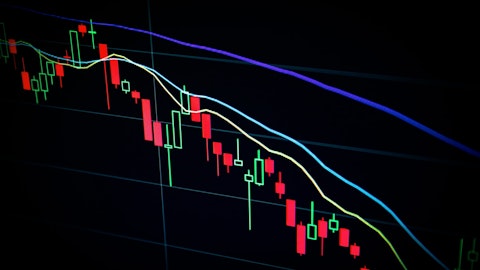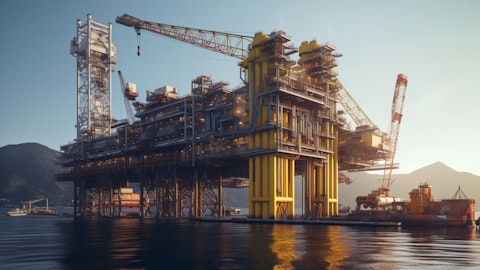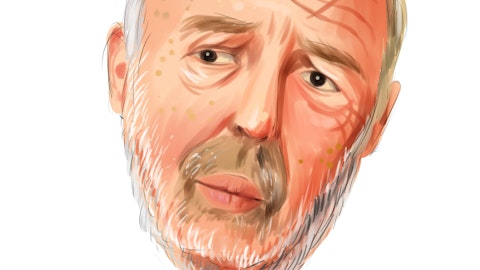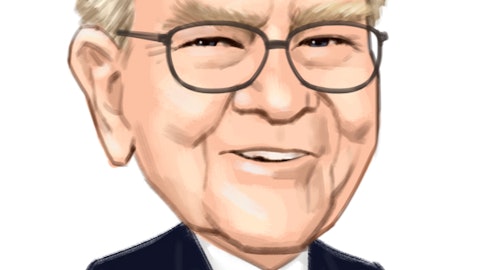Chevron Corporation (NYSE:CVX) Q3 2023 Earnings Call Transcript October 27, 2023
Chevron Corporation misses on earnings expectations. Reported EPS is $3.49 EPS, expectations were $3.63.
Operator: Good morning. My name is Katie, and I will be your conference facilitator today. Welcome to Chevron’s Third Quarter 2023 Earnings Conference Call. At this time, all participants are in a listen-only mode. After the speakers’ remarks, there will be a question-and-answer session and instructions will be given at that time. [Operator Instructions] As a reminder, this conference call is being recorded. I will now turn the conference call over to General Manager of Investor Relations of Chevron Corporation, Mr. Jake Spiering. Please go ahead.
Jake Spiering: Thank you, Katie. Welcome to Chevron’s third quarter 2023 earnings conference call and webcast. I’m Jake Spiering, General Manager of Investor Relations. Our Chairman and CEO, Mike Wirth, and CFO, Pierre Breber, are on the call with me today. We will refer to the slides and prepared remarks that are available on Chevron’s website. Before we begin, please be reminded that this presentation contains estimates, projections and other forward-looking statements. Please review the cautionary statement on Slide 2. Now, I will turn it over to Mike.
Michael Wirth: Thanks, Jake. I want to start by acknowledging the tragic events in the Middle East. We are deeply saddened by the loss of life, and our hearts go out to those affected by the war. We continue to prioritize the safety and well-being of our employees and their families and the safe delivery of natural gas. Earlier this week, we announced that Chevron entered into a definitive agreement to acquire Hess Corporation. We expect this transaction to close in the first half of 2024. And we look forward to providing updates in the future. Now turning to the third quarter. We continued to make progress on our objective to safely deliver higher returns and lower carbon by returning more than $5 billion to shareholders for the sixth consecutive quarter and delivering ROCE greater than 12% for the ninth consecutive quarter; and investing in traditional energy by closing the PDC Energy acquisition and in new energies by acquiring a majority stake in a green hydrogen production and storage hub in Utah.
And earlier this month, we released our Climate Change Resilience Report which details our approach, actions and progress in reducing carbon intensity and growing new, lower carbon businesses. I encourage everyone to read the report, available on Chevron.com. At TCO, base business continues to deliver good results. The planned turnaround was completed ahead of schedule, the reservoir is performing well and the plant remains full. We expect a higher dividend in the fourth quarter. TCO has achieved mechanical completion at the Future Growth Project. Following slower-than-expected commissioning progress, we conducted an independent cost and schedule review. We now forecast the Wellhead Pressure Management Project, which is the field conversion from high pressure to low pressure, to begin start-up in the first half of 2024 and to continue through two major train turnarounds.
FGP is expected to start-up in the first half of 2025 and ramp to full production within three months. Total project cost is expected to increase between 3% to 5%. TCO production on a 100% basis in 2024 is forecasted to be about 50,000 barrels of oil equivalent per day lower than 2023 due to a heavier turnaround schedule and planned downtime for WPMP conversions. TCO is expected to reach greater than 1 million barrels of oil equivalent per day in 2025 when FGP fully ramps up. Free cash flow from TCO in 2025 is expected to be more than $4 billion, Chevron’s share at $60 Brent, down around $1 billion from our prior estimate. Our focus remains on safe and reliable commissioning and start-up. I’ll now turn it over to Pierre to discuss the financials.

Pierre Breber: Thanks, Mike. We delivered another quarter with strong earnings, cash flow and ROCE. This quarter’s results included two special items: a one-time tax benefit of $560 million in Nigeria and pension settlement costs of $40 million. Foreign currency benefits were $285 million. The appendix of this presentation contains a reconciliation of non-GAAP measures. Organic CapEx this quarter included about $200 million for PDC legacy operations after closing in August. Our balance sheet remains strong, ending the quarter with a net debt ratio in the single digits. Another quarter of solid cash flow enabled us to deliver on all of our financial priorities. Despite restrictions during the PDC transaction, we were able to repurchase well over $3 billion in Chevron shares.
Cash used to reduce debt was primarily related to PDC’s higher cost borrowing. Cash balances ended the quarter near $6 billion, a little above what’s needed to run our businesses. Adjusted third quarter earnings were down $5.1 billion versus the same quarter last year. Adjusted upstream earnings were lower mainly due to realizations and negative timing effects. Higher unfavorable discrete tax charges and exploration expenses were partly offset by lower DD&A, Venezuela cash recoveries and other favorable items. Adjusted downstream earnings decreased primarily due to a negative swing in timing effects and lower marketing margins. Compared with last quarter, adjusted earnings were down just over $50 million. Adjusted upstream earnings were roughly flat as higher prices and volumes were offset by unfavorable discrete tax charges and negative timing effects due to the rise in prices.
DD&A and OpEx were both higher in part due to the addition of PDC legacy assets for two months in the quarter. Adjusted downstream earnings increased primarily due to higher refining margins, partially offset by unfavorable timing effects. All other was down on unfavorable tax items and decreased interest income in line with lower cash balances. Third quarter oil equivalent production was up 6% over last quarter primarily due to two months of legacy PDC production. This was partly offset by a planned turnaround at TCO and pitstop at Gorgon. The Permian, excluding legacy PDC, was down 2% due to lower non-operated production; company-operated production was flat with the second quarter. Now, looking ahead. Our fourth quarter estimate for turnarounds and downtime includes approximately 30,000 barrels of oil equivalent per day for Tamar.
We anticipate affiliate dividends in the fourth quarter to be largely from TCO. As a reminder, we record a 15% withholding tax on TCO dividends. Due to the pending transaction with Hess, share repurchases will be restricted pursuant to SEC regulations. Chevron expects share repurchases in the fourth quarter to be around $3 billion plus or minus 20%, depending primarily on the timing of the Hess definitive proxy statement mailing. In summary, our actions and performance show that Chevron keeps delivering strong results. With a strategy that remains clear and consistent, we are well positioned to deliver value to our shareholders in any environment. With that, I’ll turn it back to Jake.
Jake Spiering: That concludes our prepared remarks. We are now ready to take your questions. To allow for questions from more participants, we ask that you limit yourself to one question. We will do our best to get all of your questions answered. Katie, please open the lines.
Operator: Thank you. [Operator Instructions] We’ll take our first question from Roger Read with Wells Fargo.
See also Dividend Stock Portfolio: 15 Stocks To Buy According to Reddit and 30 Biggest Developing Countries in the World.
Q&A Session
Follow Chevron Corp (NYSE:CVX)
Follow Chevron Corp (NYSE:CVX)
Roger Read: Yes. Thank you. Good morning. I was hoping we could dig into the international upstream, just a little short on what we were expecting this quarter, what some of the factors were, other than the ones called out, the FX issue and the tax benefit in Nigeria.
Michael Wirth: Yes, Roger. Look, I’ll let Pierre cover this in a little more detail, but there’s – I recognize this quarter was a tough one to model. And there’s pretty material or significant non-cash charges. Timing effects, primarily inventory costs, we see with rising prices some tax reserves and charges for legal abandonment and other things and then some lower realizations with your mix and the lag effect in some of our LNG pricing. On timing and inventory costs in particular, on period-to-period comparisons where we had a prior period, whether it was last quarter or the same quarter last year, where prices were coming down and then in the current period, we see prices strengthening significantly, you really get pretty significant deltas on the way we cost inventory.
And if you go back to the, I think, the first quarter of 2022, we had some similar dynamics. So anyway, that’s kind of high level on it. Pierre, maybe you can talk a little bit more about the upstream and international upstream in particular.
Pierre Breber: Yes, it’s a subset of what you talked to, Mike, Roger. So timing effects, the largest timing effects this quarter were on cargoes on the water. So you’ll see that primarily in the international upstream, international downstream. Timing effects are in three buckets. You have paper mark-to-market, you have on-the-water inventory and then you have on-land inventory. So it’s really cargoes on the water that drive most of the effect, cargoes that are in transit and cross over quarterly periods. And so that’s what the trajectory of prices, as Mike indicated, is really what drives that. Mike talked about abandonment estimate. So those will show up in depreciation. And we saw that in the international upstream. And then in LNG, you see some lag pricing.
We also saw some mix between contract cargoes and spot cargoes on LNG. And on the liquid side, we saw some mix effects. So it’s a bit of where the liftings are relative to production in terms of tax jurisdictions, the types of products, how they trade in terms of discounts to Brent. So there were a number of items in international upstream. And you could follow-up, Roger, with Jake and cover any more details.
Roger Read: No, thanks. I’ll sum it up as messy. I appreciate it. Thanks.
Michael Wirth: We gave [indiscernible] quarter every now and again. Go ahead, Katie.
Operator: I apologize. We’ll take our next question from Josh Silverstein with UBS.
Joshua Silverstein: Yes. Thanks. Good morning, guys. On the TCO, you had mentioned that in 2025, you expect the cash flow to be about $1 billion lower, around $4 billion versus $5 billion previously. Is that just due to the project delays? Or is there higher cost estimates now in that, so it would be lower distributions from there? Or is there something else that’s driving that?
Michael Wirth: Yes. So Josh, there’s going to be some more capital, we said 3% to 5%. So think about around $1 billion Chevron share over 2024 and 2025, probably a little more weighted to 2024 than 2025. Cash flow from the operations will be lower by about $1.5 billion at $60 Brent in total over the next two years really due to the delay in the project. So it’s equivalent to about 50,000 barrels a day in net production in each of those years. So in total, we expect our share of dividends to be lower by about $2.5 billion across 2024 and 2025 from the prior guidance. And so it’s a combination of those things. And so we had previously guided to above $5 billion. We’re now seeing above $4 billion and a little more of that coming from production and cash flow from ops as opposed to CapEx.
Pierre Breber: And the delay in WPMP doesn’t have any impact really because there was no incremental production. So the effects that Mike was talking about in production are really from the delay in the start-up of FGP, which obviously adds incremental production.





